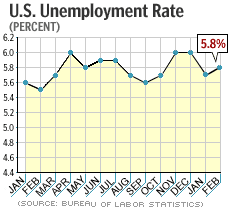NEW YORK (CNN/Money) - The confidence of U.S. consumers, whose spending fuels more than two-thirds of the nation's economy, dipped slightly in the days before a U.S.-led war with Iraq, a research group said Tuesday.
Though confidence remains at the lowest levels in nearly a decade, the future course of consumer spending will depend in part on the progress of the war and the condition of the labor market in the months ahead.

The Conference Board, a business research group based in New York, said its closely watched index of consumer confidence sank to 62.5 from a revised 64.8 in February.
It was the lowest reading for consumer confidence since a 60.5 reading in October 1993. Economists, on average, had expected a reading of 62.4, according to a Reuters poll.
The survey's "expectations" index fell to 62.5 from 65.7 in February. The "present situation" index fell to 62.4 from 63.5.
The report had little impact on U.S. stock prices, which rose in midday trading. Treasury bond prices rose.
War news will affect sentiment
The survey of 5,000 households ended on March 18, before the beginning of the war. Other consumer surveys, including the ABC/Money poll, due Tuesday night, and an updated March survey by the University of Michigan, due on Friday, will reveal more about how consumer sentiment has fared in the first days of the war.
After that, the course of consumer confidence could closely follow the course of the war's progress.
| Related stories
|

|
|
|
|
"If the war's prospects improve from here, consumer optimism is likely to improve, while if we see further setbacks of the type we experienced this past weekend, then we must be prepared to see a dip in consumer sentiment threatening to slow the pace of consumer spending further," said Anthony Chan, chief economist of Banc One Investment Advisors.
And even after the war is over, it will take time to sort out how much damage has been done to the underlying economy by war fears and other problems.
Clearly, retail sales were hurt in the first week of the war by the so-called "CNN effect," a term coined during the Persian Gulf War in 1991, when consumers were too busy watching news unfold on CNN to go shopping.
ShopperTrak, a retail research group, said U.S. sales in the first four days of the war in Iraq, March 20 to March 23, were 9.9 percent lower than the same period a year ago.
Economists believe the CNN effect will be short-lived, particularly if the war progresses quickly and successfully for the United States. On the other hand, if the recent struggles of U.S. and British forces to contain resistance in parts of Iraq continue, then consumers might be glued to their TV sets a little longer.
"As long as suspense lingers, you will have a longer CNN effect," said Conference Board economist Delos Smith. "That's not what you want -- mood is very important for the retail world."
Labor market, money supply tight
Consumer mood is critical for the broader economy, too, since consumer spending makes up more than two-thirds of U.S. gross domestic product, the broadest measure of economic growth.
Consumers have kept spending despite a recession that began in March 2001 and might have ended near the beginning of 2002, which brought nearly 2 million job cuts. Consumers have also continued to spend despite terror attacks, a three-year bear market in stocks, a long buildup to war, and a spate of corporate fraud.

But some economists are worried frazzled consumers can't carry the burden of the world's biggest economy on their shoulders indefinitely, particularly amid a dismal labor market. Among the Conference Board survey respondents, 32.3 percent said jobs were "hard to get," the highest percentage since 32.4 percent in May 1994.
"While a quick and successful outcome in the Middle East conflict would certainly ease some of the uncertainties facing consumers and therefore boost confidence, it is the economic fundamentals that will determine whether a rebound is sustainable," said Lynn Franco, director of the Conference Board's Consumer Research Center.
Franco pointed out that the end of the first Gulf War in 1991 gave consumer confidence a quick boost, but lingering labor-market woes brought confidence right back down.
And Northern Trust economist Paul Kasriel pointed out recently that the growth of a key measure of money supply, adjusted for inflation, fell in February to its slowest pace since February 2001 -- just before the latest recession began.
"M2" money growth is the name economists give to a basket of liquidity measures, including the amount of currency in circulation, money in savings accounts and more. M2 money growth, Kasriel pointed out, has closely tracked growth in consumer spending -- with a few exceptions here and there -- for the past 40 years or so.
And money supply's latest slowdown as consumers have started to save more -- the percentage of disposable income socked away has been above 3.9 percent for the past five months, the longest such stretch since early 1999.
In order to keep the economy moving, the Federal Reserve, which last week decided to leave its target for short-term interest rates alone, might have to cut rates again.
The Fed said it thought its key short-term rate, already at a 40-year low, was low enough to accommodate future growth by keeping borrowing costs low, but several economists think the Fed might have to cut rates again in May or June, no matter how the war goes.
"When the fog of war is finally lifted, we may find that economic growth remains weak because monetary policy turns out to be less accommodative than the Fed thought," Kasriel wrote in a research note last week.

|

